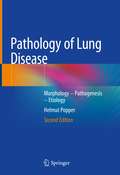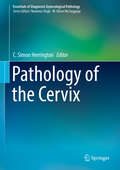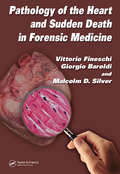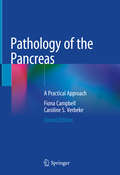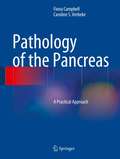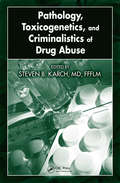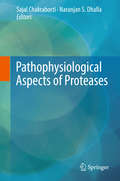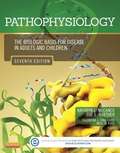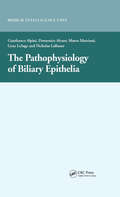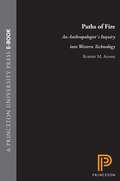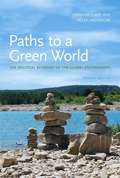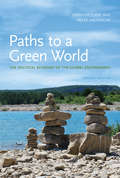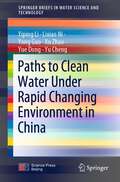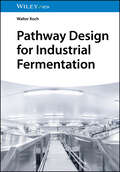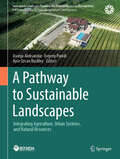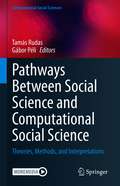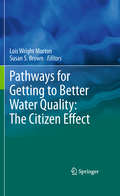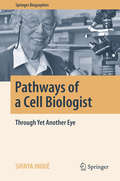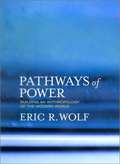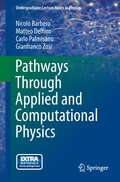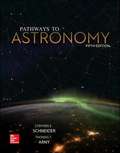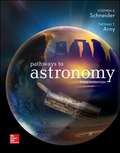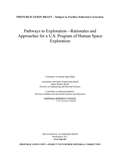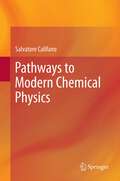- Table View
- List View
Pathology of Lung Disease: Morphology – Pathogenesis – Etiology
by Helmut PopperThis well-illustrated book covers the full range of lung and pleural diseases from the pathologic standpoint. It has been updated from the first edition by including the most recent molecular data for the different lung diseases, tumor as well as non-tumor ones. New diagnostic tests are included, new aspects for the understanding of diseases have been added. Both diseases of adults and pediatric lung diseases are presented. The chapter on lung development has been expanded due to the many new findings being reported since the first edition.The book will serve as an excellent guide to the diagnosis of these diseases, but in addition it explains the disease mechanisms and etiology. Genetics and molecular biology are also discussed whenever necessary for a full understanding. The author is an internationally recognized expert who runs courses on lung and pleural pathology attended by participants from all over the world. In compiling this book, he has drawn on more than 30 years’ experience in the field.
Pathology of the Cervix
by C. Simon HerringtonThis is the third volume in the Essentials of Diagnostic Gynecological Pathology series sponsored by the British Association of Gynecological Pathologists. Focusing on cervical pathology, it provides an update on current diagnostic criteria, the use of biomarkers and specimen handling. It serves as a quick desktop reference facilitating accurate diagnosis, and also provides detailed descriptions and an exhaustive reference list for more in-depth study. Sections devoted to the changing landscape of cervical screening, current management and future directions are included. Standardized terminology, the biology of HPV-related pre-invasive disease, and the staging of early cervical cancers are discussed. As most histopathology departments receive many gynecological specimens, Pathology of the Cervix has been written to be useful diagnostically to general as well as specialist gynecological pathologists and pathologists in training. Gynecologists, oncologists, dermatologists, genitourinary physicians and cancer nurse specialists will find expert insights here that will help in treatment and counselling of their patients.
Pathology of the Developing Mouse: A Systematic Approach
by Brad BolonPathology of the Developing Mouse provides, in so far as feasible, one complete reference on the design, analysis, and interpretation of abnormal findings that may be detected in developing mice before and shortly after birth. In particular, this book is designed specifically to be not only a "how to do" manual for developmental pathology expe
Pathology of the Heart and Sudden Death in Forensic Medicine
by Vittorio Fineschi Giorgio Baroldi Malcolm D. SilverAddressing the pathology of the heart and cardiovascular system from a forensic perspective, Pathology of the Heart and Sudden Death in Forensic Investigations guides the pathologist toward the effective resolution of cases. It critically reviews pertinent facts by revisiting pathologic findings and comparing them to etiopathogenic hypotheses, prop
Pathology of the Pancreas: A Practical Approach
by Fiona Campbell Caroline S. VerbekeThis updated volume provides a practical guide to pancreatic pathology that covers recent changes in concepts and classifications. Potential pitfalls and mimics in pancreatic pathology are highlighted and illustrated, and guidance is provided regarding how to recognise and avoid them. There is a new chapter on transplant pathology, and more than 200 new macroscopic and microscopic images have been added. Pathology of the Pancreas: A Practical Approach aims to enable readers to recognise the various pathological entities and provide the key information in their pathology reports, which is necessary for the individual patient’s further management. The book provides the diagnostic pathologist with a comprehensive, well-illustrated, and extensively cross-referenced approach to pancreatic pathology.
Pathology of the Pancreas
by Caroline S. Verbeke Fiona CampbellPathology of the Pancreas: A Practical Approach covers all the diagnostic entities in adult pancreatic pathology, providing extensive illustrations and tables to assist the pathologist at the time of diagnostic reporting of histological and cytological specimens. Potential pitfalls and mimics in pancreatic pathology are highlighted and illustrated, and guidance is provided regarding how to recognize and avoid them. Pathology of the Pancreas: A Practical Approach enables the pathologist to recognize the various pathological entities and provide the key information in their pathology reports, which is necessary for the individual patient's further management. It is based on the most recent diagnostic algorithms, international consensus guidelines, and systems for disease classification, staging and grading. Clinical information is also included, where it is important for the multidisciplinary team management discussion. Pathology of the Pancreas: A Practical Approach is a bench book for everyday use beside the microscope and provides the diagnostic pathologist with a comprehensive, well-illustrated and extensively cross-referenced approach to pancreatic pathology.
Pathology, Toxicogenetics, and Criminalistics of Drug Abuse
by Steven B. KarchBeginning with a definition and explanation of scheduling of controlled substances, Pathology, Toxicogenetics, and Criminalistics of Drug Abuse covers investigative methods for all illegal drugs and several legitimate pharmaceuticals that are used illicitly, including steroids. It covers the latest techniques used to analyze drugs in the forensic laboratory including physical characteristics and chemical confirmatory tests. It discusses new theories and findings in toxicogenetics, details pathologic changes in the body due to drug use, and examines specific effects on the heart, lung, and central nervous system. More that 70 tables and figures illustrate and complement the text and the information is supported by extensive references
Pathophysiological Aspects of Proteases
by Naranjan S. Dhalla Sajal ChakrabortiThis book provides a comprehensive overview of the multifaceted field of protease in the cellular environment and focuses on the recently elucidated functions of complex proteolytic systems in physiology and pathophysiology. Given the breadth and depth of information covered in the respective contributions, the book will be immensely useful for researchers working to identify targets for drug development. Multidisciplinary in scope, the book bridges the gap between fundamental and translational research, with applications in the biomedical and pharmaceutical industry, making it a thought-provoking read for basic and applied scientists engaged in biomedical research. Proteases represent one of the largest and most diverse families of enzymes known, and we now know that they are involved in every aspect of a given organism's life functions. Under physiological conditions, proteases are regulated by their endogenous inhibitors. However, when the activity of proteases is not correctly regulated, disease processes such as tumour progression, vascular remodelling, atherosclerotic plaque progression, ulcer, rheumatoid arthritis, Alzheimer's disease and inflammation can result. Many infective microorganisms require proteases for replication or use them as virulence factors, which has facilitated the development of protease-targeted therapies for a variety of parasitic diseases.
Pathophysiology: The Biologic Basis for Disease in Adults and Children (Seventh Edition)
by Kathryn L. Mccance Sue E. HuetherWritten by well-known educators Kathryn McCance and Sue Huether, and joined by a team of expert contributors, this resource is the most comprehensive and authoritative pathophysiology text available! A fully updated glossary includes 1,000 terms, and makes lookup easier by grouping together similar topics and terms. Outstanding authors Kathryn McCance and Sue Huether have extensive backgrounds as researchers and instructors, and utilize expert contributors, consultants, and reviewers in developing this edition. Chapter summary reviews provide concise synopses of the main points of each chapter. Consistent presentation of diseases includes pathophysiology, clinical manifestations, and evaluation and treatment. Lifespan content includes ten separate pediatric chapters and special sections with aging and pediatrics content. Algorithms and flowcharts of diseases and disorders make it easy to follow the sequential progression of disease processes. Nutrition and Disease boxes explain the link between concepts of health promotion and disease. EXTENSIVELY Updated content reflects advances in pathophysiology including tumor biology invasion and metastases, the epidemiology of cancer, diabetes mellitus, insulin resistance, thyroid and adrenal gland disorders, female reproductive disorders including benign breast diseases and breast cancer, and a separate chapter on male reproductive disorders and cancer. NEW! Chapter on epigenetics and disease. Additional What's New boxes highlight the most current research and clinical development.
The Pathophysiology of Biliary Epithelia
by Gianfranco AlpiniThis book is a comprehensive review of the biliary epithelia pathophysiology. Biliary epithelial cells (also referred to as cholangiocytes) line the intra- and extrahepatic bile ducts. Cholangiocytes have immerged in the last several years as one of the more important epithelial cells in the gastrointestinal system due to their large contribution to bile formation and tendency to be involved in human diseases.The book’s 35 chapters represent a nearly complete review of the function and disease of bile ducts. The gestational development of bile ducts is shown to be a complex interaction between hepatocyte and biliary precursors. The structure of bile ducts can be defined by ultrastructural studies and by 3D reconstruction studies which show that the bile duct system resembles a tree. The array of membrane transporters and channels involved in ductal absorption and secretion of water and electrolytes is reviewed. Like other gastrointestinal epithelial cells, the physiologic responses of cholangiocytes are regulated by hormones, nerve input, cytokines, factors in bile and intracellular signals (e.g., cyclic AMP and intracellular calcium). The potential role of the cholangiocyte in production of collagen in cholestatic liver disease is discussed. A number of important models used in the study of cholangiocyte physiology and reactions to injury are reviewed. Finally the relationships between the cholangiocyte responses and human liver diseases are discussed.While many basic scientists and hepatologists who devote their careers to the study of the liver will find this book useful, the intended audience of this book is the more heterogeneous group of individuals who study clinical and/ or basic science digestive physiology and due to their interest in epithelial function will find the cutting edge information in this book both enlightening and useful to their progression of their work.
Paths of Fire: An Anthropologist's Inquiry into Western Technology
by Robert M. AdamsTechnology, perhaps the most salient feature of our time, affects everything from jobs to international law yet ranks among the most unpredictable facets of human life. Here Robert McC. Adams, renowned anthropologist and Secretary Emeritus of the Smithsonian Institution, builds a new approach to understanding the circumstances that drive technological change, stressing its episodic, irregular nature. The result is nothing less than a sweeping history of technological transformation from ancient times until now. Rare in antiquity, the bursts of innovations that mark the advance of technology have gradually accelerated and now have become an almost continuous feature of our culture. Repeatedly shifting in direction, this path has been shaped by a host of interacting social, cultural, and scientific forces rather than any deterministic logic. Thus future technological developments, Adams maintains, are predictable only over the very short term.Adams's account highlights Britain and the United States from early modern times onward. Locating the roots of the Industrial Revolution in British economic and social institutions, he goes on to consider the new forms of enterprise in which it was embodied and its loss of momentum in the later nineteenth century. He then turns to the early United States, whose path toward industrialization initially involved considerable "technology transfer" from Britain. Propelled by the advent of mass production, world industrial leadership passed to the United States around the end of the nineteenth century. Government-supported research and development, guided partly by military interests, helped secure this leadership.Today, as Adams shows, we find ourselves in a profoundly changed era. The United States has led the way to a strikingly new multinational pattern of opportunity and risk, where technological primacy can no longer be credited to any single nation. This recent trend places even more responsibility on the state to establish policies that will keep markets open for its companies and make its industries more competitive. Adams concludes with an argument for active government support of science and technology research that should be read by anyone interested in America's ability to compete globally.
Paths to a Green World
by Jennifer Clapp Peter DauvergneThis comprehensive and accessible book fills the need for a political economy view of global environmental politics, focusing on the ways international economic processes affect environmental outcomes. It examines the main actors and forces shaping global environmental management, particularly in the developing world. Moving beyond the usual emphasis on international agreements and institutions, it strives to capture not only academic theoretical debates but also views on politics, economics, and the environment within the halls of global conferences, on the streets during antiglobalization protests, and in the boardrooms of international agencies, nongovernmental organizations, and industry associations. The book maps out an original typology of four contrasting worldviews of environmental change--those of market liberals, institutionalists, bioenvironmentalists, and social greens--and uses them as a framework to examine the links between the global political economy and ecological change. This typology provides a common language for students, instructors, and scholars to discuss the issues across the classical social science divisions. The second edition of this popular text has been thoroughly revised and updated to reflect recent events, including the food crisis of 2007-2008, the financial meltdown of 2008, and the Copenhagen Climate Conference of 2009. Topics covered include the environmental implications of globalization; wealth, poverty, and consumption; global trade; transnational corporations; and multilateral and private finance.
Paths to a Green World, second edition: The Political Economy of the Global Environment
by Jennifer Clapp Peter DauvergneA new edition of a book that takes a comprehensive look at the ways economic processes affect global environmental outcomes. This comprehensive and accessible book fills the need for a political economy view of global environmental politics, focusing on the ways international economic processes affect environmental outcomes. It examines the main actors and forces shaping global environmental management, particularly in the developing world. Moving beyond the usual emphasis on international agreements and institutions, it strives to capture not only academic theoretical debates but also views on politics, economics, and the environment within the halls of global conferences, on the streets during antiglobalization protests, and in the boardrooms of international agencies, nongovernmental organizations, and industry associations. The book maps out an original typology of four contrasting worldviews of environmental change—those of market liberals, institutionalists, bioenvironmentalists, and social greens—and uses them as a framework to examine the links between the global political economy and ecological change. This typology provides a common language for students, instructors, and scholars to discuss the issues across the classical social science divisions.The second edition of this popular text has been thoroughly revised and updated to reflect recent events, including the food crisis of 2007-2008, the financial meltdown of 2008, and the Copenhagen Climate Conference of 2009. Topics covered include the environmental implications of globalization; wealth, poverty, and consumption; global trade; transnational corporations; and multilateral and private finance.
Paths to Clean Water Under Rapid Changing Environment in China (SpringerBriefs in Water Science and Technology)
by Yiping Li Lixiao Ni Yong Guo Xu Zhao Yue Dong Yu ChengThis book mainly provides the current status of water pollution faced by China under rapid changing environment and the actions that have been taken for prevention and treatment of water pollution. It points out that the water pollution situation is severe. Facing water pollution, China’s experiences include several aspects on source control and pollution interception, internal nutrient removal of sediment, ecological restoration, and water transfer policy. There exists both the opportunity and challenge for the prevention and control of water pollution in China. The book contains numerous charts and diagrams which further illustrating China’s paths to clean water.
Pathway Design for Industrial Fermentation
by Walter KochPathway Design for Industrial Fermentation Explore the industrial fermentation processes of chemical intermediates In Pathway Design for Industrial Fermentation, distinguished researcher Dr. Walter Koch delivers an expert overview on industrial fermentation production technology as compared with natural extraction, organic chemistry, and biocatalysis. The book offers key insights for professionals designing and monitoring fermentation processes. The author explores the applications, alternative production, biochemical pathways, metabolic engineering strategy, and downstream processing of various products—including C1 to C6 products—with a focus on low-value products with market prices below 4€ per kilogram. Products will include methane, ethane, acetate, lactic acid, alanine, and others. With specific commentary and insightful perspectives on the cost drivers and technological aspects critical to commercially successful applications, the book also includes: Thorough introductions to methane, ethanol, acetate, lactic acid, alanine, and 3-Hydroxypropionic acid Comprehensive explorations of 1,3-Propanediol, butanol, isobutanol, and isobutene Practical discussions of 1,4-butanediol, succinic acid, itaconic acid, and glutamic acid Fulsome treatments of isoprene, pentamethylenediamine, lysine, citric acid, and adipic acid Perfect for process engineers, biotechnologists, and chemical engineers, Pathway Design for Industrial Fermentation will also benefit biochemists and professionals working in the chemical and food industries.
A Pathway to Sustainable Landscapes: Integrating Agriculture, Urban Systems, and Natural Resources (Sustainable Landscape Planning and Natural Resources Management)
by Asonja Aleksandar Evgeny Panidi Ayse Ozcan BuckleyThis book presents a collection of revolutionary research and case studies exploring innovative approaches to sustainable landscape design, green infrastructure, agricultural systems, geospatial technologies, and the development of resilient and livable cities. As the world faces escalating environmental challenges stemming from climate change, resource depletion, and biodiversity loss, there is an urgent need to identify and implement sustainable solutions. This book contributes to this imperative by showcasing research that advances both theoretical and practical knowledge in key domains critical to environmental sustainability and community resilience. The contributions in this book highlight the crucial role that cities play in addressing the global sustainability crisis. As urban populations continue to grow, so too do the demands on infrastructure, resources, and energy systems. Reconciling these increasing urban pressures with the need to protect and restore natural ecosystems is a central focus of the research presented. The chapters explore novel applications of renewable energy, green infrastructure, regenerative agriculture, and geospatial technologies as means of cultivating more ecologically sound and livable cities. Furthermore, the interdisciplinary nature of the research, spanning disciplines such as urban planning, environmental science, and agricultural technology, underscores the multifaceted nature of the sustainability transition. Collectively, the insights and case studies offered in this book provide invaluable guidance for researchers, policymakers, and practitioners dedicated to realizing a more equitable and environmentally resilient future.
Pathways Between Social Science and Computational Social Science: Theories, Methods, and Interpretations (Computational Social Sciences)
by Tamás Rudas Gábor PéliThis volume shows that the emergence of computational social science (CSS) is an endogenous response to problems from within the social sciences and not exogeneous. The three parts of the volume address various pathways along which CSS has been developing from and interacting with existing research frameworks. The first part exemplifies how new theoretical models and approaches on which CSS research is based arise from theories of social science. The second part is about methodological advances facilitated by CSS-related techniques. The third part illustrates the contribution of CSS to traditional social science topics, further attesting to the embedded nature of CSS. The expected readership of the volume includes researchers with a traditional social science background who wish to approach CSS, experts in CSS looking for substantive links to more traditional social science theories, methods and topics, and finally, students working in both fields.
Pathways for Getting to Better Water Quality: The Citizen Effect
by Susan S. Brown Lois Wright MortonThis book is about accomplishing change in how land is managed in agricultural watersheds. Wide-ranging case studies repeatedly document that plans, policies, and regulations are not adequate substitutes for the empowerment of people. Ultimately change on the land is managed and accomplished by the people that live on land within each watershed.
Pathways of a Cell Biologist
by Shinya InouéThis book is the autobiography of Shinya Inoué, tracing his life from childhood to the present. Though he has made many contributions to science, perhaps the most remarkable one involves the visualization of dynamics in living cells by means of a polarizing light microscope, an innovation that changed the face of cell biology. Addressing readers curious to know why and how he achieved such success, the story begins with a prologue describing the end of World War II and Inoué's lifelong collaborator, the great cell biologist Katsuma Dan. Following the prologue, the author's childhood and teenage experiences during World War II are described, before the focus shifts to his scientific career and personal life. The book not only offers important tips for young researchers, it will also help them develop a passion for science.
Pathways of Power: Building an Anthropology of the Modern World
by Eric R. WolfPosthumous collection of one of the world's leading anthropologists, spanning well over half a century of scholarship and including both well-known pieces, lesser-known not-easily-accessible pieces, and a few entirely unpublished pieces.
Pathways Through Applied and Computational Physics
by Nicolò Barbero Matteo Delfino Carlo Palmisano Gianfranco ZosiThis book is intended for undergraduates and young researchers who wish to understand the role that different branches of physics and mathematics play in the execution of actual experiments. The unique feature of the book is that all the subjects addressed are strictly interconnected within the context of the execution of a single experiment with very high accuracy, namely the redetermination of the Avogadro constant NA, one of the fundamental physical constants. The authors illustrate how the basic laws of physics are applied to describe the behavior of the quantities involved in the measurement of NA and explain the mathematical reasoning and computational tools that have been exploited. It is emphasized that all these quantities, although pertaining to a specific experiment, are of wide and general interest. The book is organized into chapters covering the interaction of electromagnetic radiation with single crystals, linear elasticity and anisotropy, propagation of thermal energy, anti-vibration mounting systems, and data analysis and B-spline interpolation. An essential feature is the focus on the role of Mathematica, an invaluable, fully integrated software environment for handling diverse scientific and technical computations.
Pathways to Astronomy (Fifth Edition)
by Stephen E. Schneider Thomas T. ArnyCreated by two veteran teachers of astronomy, both recipients of outstanding teaching awards, Pathways breaks down introductory astronomy into its component parts. The huge and fascinating field of astronomy is divided into 86 Units from which you can selectively choose topics according to your interests, while maintaining a natural flow of presentation. One of the frustrations created by other current astronomy textbooks is that each chapter covers such a wide array of topics that it is difficult for students to absorb the large amount of material, and the texts are wed to such a specific order of presentation that it is difficult for the professor to link the chapter readings and review questions to his or her own particular approach to teaching the subject. Whether you are learning astronomy for the first time or teaching it for the tenth, Pathways offers greater flexibility for exploring astronomy in the way you want to.
Pathways to Astronomy (Fourth Edition)
by Stephen Schneider Thomas Arny<p>Created by two veteran teachers of astronomy, both recipients of outstanding teaching awards, Pathways breaks down introductory astronomy into its component parts. The huge and fascinating field of astronomy is divided into 86 Units from which you can selectively choose topics according to your interests, while maintaining a natural flow of presentation. One of the frustrations created by other current astronomy textbooks is that each chapter covers such a wide array of topics that it is difficult for students to absorb the large amount of material, and the texts are wed to such a specific order of presentation that it is difficult for the professor to link the chapter readings and review questions to his or her own particular approach to teaching the subject. <p>Whether you are learning astronomy for the first time or teaching it for the tenth, Pathways offers greater flexibility for exploring astronomy in the way you want to. The Unit structure allows the new learner and the veteran professor to relate the text more clearly to college lectures. Each Unit is small enough to be easily tackled on its own or read as an adjunct to the classroom lecture. For the faculty member who is designing a course to relate to current events in astronomy or a particular theme, the structure of Pathways makes it easier to assign reading and worked problems that are relevant to each topic. For the student of astronomy, Pathways makes it easier to digest each topic and to clearly relate each Unit to lecture material.</p>
Pathways to Exploration: Rationales and Approaches for a U.S. Program of Human Space Exploration
by Committee on Human SpaceflightThe United States has publicly funded its human spaceflight program on a continuous basis for more than a half-century, through three wars and a half-dozen recessions, from the early Mercury and Gemini suborbital and Earth orbital missions, to the lunar landings, and thence to the first reusable winged crewed spaceplane that the United States operated for three decades. Today the United States is the major partner in a massive orbital facility - the International Space Station - that is becoming the focal point for the first tentative steps in commercial cargo and crewed orbital space flights. And yet, the long-term future of human spaceflight beyond this project is unclear. Pronouncements by multiple presidents of bold new ventures by Americans to the Moon, to Mars, and to an asteroid in its native orbit, have not been matched by the same commitment that accompanied President Kennedy\'s now fabled 1961 speech-namely, the substantial increase in NASA funding needed to make it happen. Are we still committed to advancing human spaceflight? What should a long-term goal be, and what does the United States need to do to achieve it? "Pathways to Exploration" explores the case for advancing this endeavor, drawing on the history of rationales for human spaceflight, examining the attitudes of stakeholders and the public, and carefully assessing the technical and fiscal realities. This report recommends maintaining the long-term focus on Mars as the horizon goal for human space exploration. With this goal in mind, the report considers funding levels necessary to maintain a robust tempo of execution, current research and exploration projects and the time/resources needed to continue them, and international cooperation that could contribute to the achievement of spaceflight to Mars. According to "Pathways to Exploration," a successful U. S. program would require sustained national commitment and a budget that increases by more than the rate of inflation. In reviving a U. S. human exploration program capable of answering the enduring questions about humanity's destiny beyond our tiny blue planet, the nation will need to grapple with the attitudinal and fiscal realities of the nation today while staying true to a small but crucial set of fundamental principles for the conduct of exploration of the endless frontier. The recommendations of "Pathways to Exploration" provide a clear map toward a human spaceflight program that inspires students and citizens by furthering human exploration and discovery, while taking into account the long-term commitment necessary to achieve this goal.
Pathways to Modern Chemical Physics
by Salvatore CalifanoIn this historical volume Salvatore Califano traces the developments of ideas and theories in physical and theoretical chemistry throughout the 20th century. This seldom-told narrative provides details of topics from thermodynamics to atomic structure, radioactivity and quantum chemistry. Califano's expertise as a physical chemist allows him to judge the historical developments from the point of view of modern chemistry. This detailed and unique historical narrative is fascinating for chemists working in the fields of physical chemistry and is also a useful resource for science historians who will enjoy access to material not previously dealt with in a coherent way.
